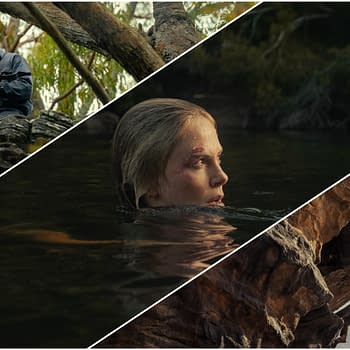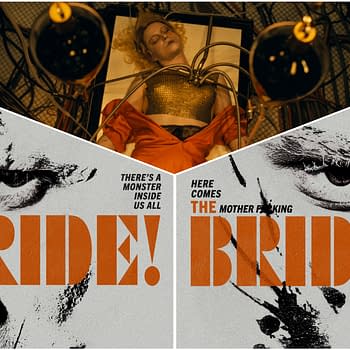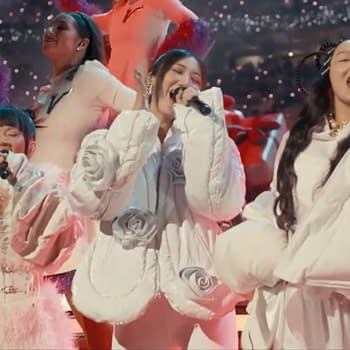Posted in: Movies | Tagged: Alan Moore, Dai Kaiju, Daiei Studios, death note, entertainment, film, Gamera 2: Attack of Legion, Gamera 3: Revenge of Iris, Gamera Trilogy, ghost in the shell, godzilla, Godzilla Mothra King Ghidorah: Giant Monsters All-Out Attack, Godzilla: Final Wars, hideo kojima, Kazunori Ito, mamoru oshii, Meta Gear Solid, Mystery Science Theatre, Shusuke Kaneko, swamp thing, The Heisei Trilogy
When Gamera Got An Alan Moore-style Reboot – Look! It Moves! By Adi Tantimedh
Adi Tantimedh writes:
For the fans and pop culture watchers who like to watch these things, the new Godzilla movie is eagerly-awaited, and the studios are taking advantage of this interest by releasing the older movies on remastered Blu-Ray, including the darker, more series movies from the 1990's.
There is, however, another Dai Kaiju series that deserves attention, and that is the Gamera Trilogy from the 1990's. These movies are considered by fans of the genre to be the ones the new Godzilla movie has to beat.
The original Gamera movies were made in the 1960's to cash in on the dai kaiju boom that Godzilla started. Produced by Daiei Studios on smaller budgets, the Gamera movies were more kid-friendly with the character designed with bigger, cuter eyes and a squat body, as well as written as a friend and protector of children. The original movies ended by 1980 when interest waned. They became popular in the US due to syndication on TV in the 1970's and then the 1990's when Mystery Science Theater 3000 cheerfully and lazily snarked at its cheap effects and campy production values. That all changed in 1995 when director Shusuke Kaneko and screenwriter Kazunori Itó rebooted the character with a proper budget.
Known in Japan as The Heisei Trilogy (after the era it was produced in) the new movies rebooted Gamera into a more epic and serious creature and myth. Kazunori Itó is a writer who's comfortable with hardcore Science Fiction themes, having previously scripted Mamoru Oshii's Patlabor movies and Ghost in the Shell, and Shusuke Kaneko is a writer-director with a thoughtful, revisionist approach to genre, whether thrillers, Science Fiction or Horror. He would go on to direct the live action movie version of the Death Note manga in 2006.
What Alan Moore did for Swamp Thing, this trilogy of movies did for a giant flying turtle.
We in the West may regard giant monster movies as kitschy, but in Japan, they're taken more serious since they tap into primal myths and folklore. Itó and Kaneko dug into Gamera and created an origin story for the creature that pushed an environmental message. Gamera was the last weapon created by the scientists of Atlantis in an attempt to save the city from creatures that evolved from their abuse of the environment. Now that those same creatures have returned, Gamera has been inadvertently reactivated to protect the world again. The reason Gamera he has a bond and affinity with children is because he was designed that way. A young girl is chosen as a priestess to bond with him keep him invested in protecting Humanity. Scientists also link him to Asian folklore about a giant tortoise as a Guardian of the North.
Where the 1984-1995 reboot of Godzilla revived the character as a force of nature and destruction to be feared, the 1990's rebooted Gamera was more of a misunderstood hero. The army consider him a threat and try to kill him because of the sheer destruction to real estate he caused in his fights, but the girl who bonded with him and other kids knew it wasn't really his fault. By the 1990's, the Godzilla movies, while A-list productions, were starting to suffer from tired scripts and sloppy direction, and Kaneko brought a darker intensity to the Gamera Trilogy. After the bright colors of the first movie Gamera, Guardian of the Universe, the sequels took on darker, more somber colors and mood in their production design. The fights and destruction also became more intense and charged than the Godzilla movies'. Where Godzilla was the prime antagonist against a greater menace, Gamera was more of an underdog and with cooler powers facing weirder, deeper stakes.
In Gamera 2: Attack of Legion, he has to face an alien monster comprised of many tiny ones, hence its biblical name. Gamera even undergoes an Alan Moore-style reconstruction into something even more epic by the end of the movie. In Gamera 3: Revenge of Iris, deep sea explorers discover a graveyard of dead Gameras at the bottom of the ocean, suggesting they were early failed prototypes the scientists of Atlantis created before they perfected him. As Gamera flies around the world battling monsters that are now popping up all over the place, a traumatized teenage girl who blames him for her parents' deaths bonds with a parasitic creature that grows into a monster designed to kill Gamera, egged on by cultists who believe he's an evil spirit.
In 1999, Gamera 3: Revenge of Iris was pretty much as far as anyone could push the boundaries of the Dai Kaiju genre. It emphasised the giant monster genre's links to religion and folklore with even more ambitious production values and setpieces. The middle of the movie features the first truly frightening scene of what happens to a late-20th Century city centre from the street-level view when giant monsters attack, using natural effects and early CGI to show the terror and destruction on a relatable scale that the 90s Godzilla movies never really managed before or since. That sense of scale and emotion is what the new Godzilla is going to have to convey in order to work. The third movie in this trilogy is the culmination and payoff to what the first one set up. Even Metal Gear Solid creator Hideo Kojima tweeted last week how watching the trilogy was an increasingly epic and emotional experience.
Kaneko proceeded to direct an actual Godzilla movie in 2001, Godzilla, Mothra, King Ghidorah: Giant Monsters All-Out Attack, bringing the same revisionist, epic take to Godzilla. This one is also considered one of the best Godzilla movies after the 1954 original, darker and more serious in tone from the campy, comedic Godzilla: Final Wars years later.
So while you're waiting for the new Godzilla to open, you could have a lot of fun checking out the Heisei Trilogy, since the Blu-Ray boxset is selling for less than $10 right now on Amazon, and Godzilla, Mothra, King Ghidorah: Giant Monsters All-Out Attack. Yes, it's giant monsters played by men in suits, but it's also a look into the Japanese zeitgeist of their time periods.
My turtles don't fly at lookitmoves@gmail.com
Follow the official LOOK! IT MOVES! twitter feed at http://twitter.com/lookitmoves for thoughts and snark on media and pop culture, stuff for future columns and stuff I may never spend a whole column writing about.
Look! It Moves! © Adisakdi Tantimedh




















